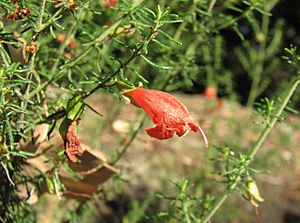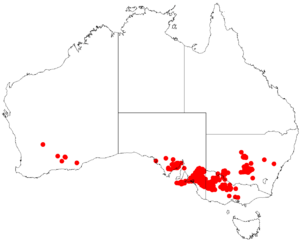Scarlet mint-bush facts for kids
Quick facts for kids Scarlet mint-bush |
|
|---|---|
 |
|
| In Maranoa Gardens | |
| Scientific classification | |
| Genus: |
Prostanthera
|
| Species: |
aspalathoides
|
 |
|
| Where it grows in Australia (data from AVH) | |
The Prostanthera aspalathoides, also known as the scarlet mint-bush, is a beautiful flowering plant. It is a type of shrub that grows only in south-eastern Australia. This plant is quite small, with fuzzy branches and leaves that smell like mint. Its flowers are usually red, pinkish-red, or orange, and they grow one by one where the leaves meet the stem.
Contents
What Does the Scarlet Mint-Bush Look Like?
The scarlet mint-bush is a neat, upright shrub. It usually grows to be about 0.3 to 1 meter (about 1 to 3 feet) tall. Its branches are covered in tiny hairs and special glands.
The leaves of this plant are very fragrant. They are shaped like cylinders or narrow ovals. Each leaf is about 1.5 to 6 millimeters long and 0.5 to 1 millimeter wide. They either attach directly to the stem or have a very short stalk (up to 0.5 mm long).
The flowers grow one at a time from where the leaves join the stem. At the base of each flower, there are small leaf-like parts called bracteoles, which are about 2 to 3 millimeters long. The sepals, which are the green parts that protect the flower bud, are 5 to 7 millimeters long. They join together at the bottom to form a tube about 3 to 4 millimeters long.
The colorful petals of the flower are 10 to 20 millimeters long. They form a tube that is usually red, pinkish-red, or orange. Sometimes, very rarely, they can be yellow. This tube is about 8 to 11 millimeters long. The scarlet mint-bush mostly blooms in spring, but you might see its flowers in other months too.
How the Scarlet Mint-Bush Got Its Name
The scarlet mint-bush was first officially described in 1834. A botanist named George Bentham wrote about it in his book Labiatarum genera et species. He used notes from another botanist, Allan Cunningham, who had found the first examples of this plant near the Lachlan River.
The plant's scientific name, aspalathoides, means that it looks similar to plants from a different group called Aspalathus.
Where the Scarlet Mint-Bush Grows
The scarlet mint-bush lives in a type of forest called mallee. You can find it in three states in Australia: New South Wales, Victoria, and South Australia.
In New South Wales, it grows west of the Rankins Springs area. In Victoria, it is found in the northern half of the state. In South Australia, you can see it in the south-east, including the Yorke and Eyre Peninsulas, and also on Kangaroo Island.
Uses of the Scarlet Mint-Bush
Growing Scarlet Mint-Bush in Gardens
The scarlet mint-bush is a great plant for gardens, especially in dry places with not much humidity. It likes to grow in sunny spots or places with a little bit of shade. It also needs soil that drains water well. This plant can handle moderate frost, which means it can survive some cold weather.
The best way to grow new scarlet mint-bush plants is by taking cuttings from an existing plant. This is because its seeds can take a very long time to sprout. Sometimes, gardeners will even graft (join) parts of the scarlet mint-bush onto the roots of a stronger plant called the snowy mint-bush (Prostanthera nivea). This helps the scarlet mint-bush grow better.
Fragrant Oil from the Plant
More than 100 years ago, a chemist named Joseph Bosisto studied Prostanthera plants. He was trying to extract a fragrant oil called cineole, also known as eucalyptol. This oil is found in many plants, including some mint-bushes.
Later tests on the scarlet mint-bush showed that it could produce a small amount of this oil, about 2-3% of its weight. This means the plant has a natural, pleasant scent!

